AACZ Kyashar Expedition
2003:
First Official Ascent
| Authors: |
B. Normand, A. Frank, S. Broderick and K. Riddell |
| Facts: |
Kyashar (also Peak 43, Tangnagtse), 6770m, Mahalangur Himal.
Coordinates: 27 45 17N, 86 49 30E.
First official ascent: B. Normand/A. Frank/S. Broderick,
W Ridge/W Face, 18.10.03.
|
Photos: |
http://www.afrank.net/Nepal2003/index.htm |
|
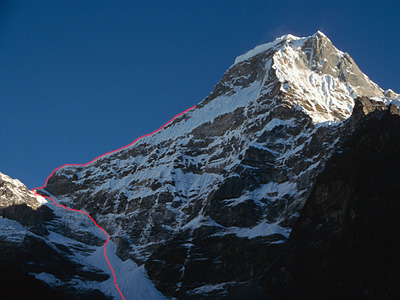 |
Official Report
The internet has taken
much of the effort out of first-ascending in the Himalaya. Now
one can surf through lists of open peaks, previous attempts, journal
references and search-engine pages of photos and text. All this
was something of a blessing for our team when Peak 41, our long-coveted
target, was climbed by a Slovenian party in December 2002. The
search for a new peak began with the list of 103 ``New Peaks Opened
to Expedition'' by HM Government of Nepal two years ago: lurking
under the name ``Kyashar'' was Peak 43, although HMG Ministry
of Tourism had helpfully muddied the waters by listing P6770 in
the upper Hongu as ``Peak 43''. The back side of the mountain
seemed to be lost in an information vacuum which the internet
couldn't help us solve, so with the irrational conviction that
something must be possible we signed on. |
 |
E-mail has also
taken the uncertainty out of expedition planning, and Ang Phurba
Sherpa at Wilderness Experience had all the answers, within a
day, on details great and small. With permit application, LO,
flights to Lukla, sirdar and cook, porter equipment and staff
insurance all under control, Bruce, as expedition leader, needed
a grand total of 24 hours to take care of business in Kathmandu.
The obligatory visit to the Department of Tourism for the signed
permit, equally obligatory interview with the irrepressible Elizabeth
Hawley, stacks of small-denomination rupees for porter salaries,
snow stakes, fixed rope, generic antibiotics and kerosene lanterns
were all dealt with, and the operation crowned by a trip to the
Bhat Bhateni supermarket with our sirdar and cook, Dhan Kumar
Rai, for a one-shot acquisition of half the expedition supplies.
|
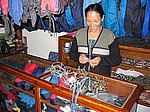 |
Bruce and Kevin
were due to fly to Lukla the following morning, missing the arriving
Andi and Sam at the airport, but Kevin was waylaid by Kathmandu
quickstep. To nobody's surprise or disappointment our LO had gone
missing, not to reappear until the final check-out at the Ministry
of Tourism. At WildEx's Lukla base, the Sherpa Lodge, Bruce and
Dhan Kumar met our second staff member and assistant cook, Pasang
Namgyal Sherpa, and the three plied the main street buying food
and vegetables, kerosene, baskets, polyethene strips for porter
raincoats and finally the essential prayer flags. Dhan Kumar was
surrounded by men looking for porter work, and with 13 of these
a further problem was solved. Andi, Sam and a recovered Kevin
were on the second flight the next day, and our porters appeared
anxious to get started, so after a brief repacking frenzy the
expedition was on the trail a mere 30 hours since Andi and Sam
had arrived on Nepalese soil. |
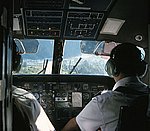 |
The Hinku trek
begins with a steep climb of the 4600m Zawtra La. Our acclimatisation
policy was to cross at speed and worry about altitude nearer BC,
which seemed just fine by our porters despite their 30kg loads
being twice what we were carrying. The monsoon had not yet pulled
back, and morning clouds would lapse into mist, then to rain by
afternoon. As a sodden and bedraggled crew descended upon Tuli
Kharka, the first teahouse on the Hinku side, aspertions were
cast on Bruce's statement that the monsoon would finish by 1st
Oct, now 30 hours away. The next day was no different, except
for the stream-crossings and slippery descent in a moss-hung cloud
forest, and brought us to Tashing Ongma, a small village by a
river terrace offering a few fields. Dhan Kumar brightened the
evening by baking a cake for Kevin's 32nd birthday. The leader's
prophesy was vindicated when 1st Oct arrived with blue skies,
although cumulus soon obscured all the peaks again. The trail
wound through the boulder-strewn river bed, then up onto grassy
meadows in real sunshine, which warmed both the bodies and the
spirits of the party. We continued to the village of Tangnag (meaning:
``black rock''), at the foot of a huge, black rock buttress which
forms the lower half of Kyashar, known in the Hinku as Tangnagtse.
|


|
True post-monsoon
weather arrived with a spectacular sunrise on Kusum Kanguru and
Kyashar. The summit of the latter, 2.5km straight above us, consisted
of a set of seracs breaking over the compact, vertical buttresses
of the upper S and SE faces. The trek led NE under the N face
of Mera, dominated every step of the way by the triangular SE
face of Kyashar. As the NE face came briefly into view our enthusiasm
was muted: steep snow flutes and mushrooms, with not inconsiderable
sections of bare rock. Our route diverged from the Mera La trail,
heading N along the lower Hinku Nup glacier, whose western moraine
provided easy trekking and beautiful views of the Malanphulan
group at the head of the glacier, the Peak 41 group across it
and Mera to the S. |
 |
The moraine
ceased to exist at a corner from which the upper glacier, BC and
Kangtega were visible. The porters were not happy with the steep,
loose descent to and impromptu route construction through the
last 2km of the glacier, and it was with some relief that the
team pulled into BC, flat and with abundant running water, by
early afternoon. The mood improved rapidly with the big rupee
payout: 4500Rs (c. 70USD) each for a nominal 10 days of work.
While 11 of the porters left to return to Tangnag in daylight,
Tenzing Sherpa and Dhan Badr Rai, who had worked in the kitchen
during the trek, stayed to help set up BC. Soon five small, coloured
flecks were decorating the otherwise stark landscape. |
 |
The first order
of BC business was to make sure the gods would look fondly upon
our presence in their mountains: Tenzing took charge of the puja,
for which he first erected a small chorten with help from Dhan
Kumar and Dhan Badr. Some of our delicacies and a bottle of Mt.
Everest whisky were produced for the tray of offerings, and sprigs
of juniper were burned to appropriate incantations as the prayer
flags were sanctified by the smoke. After a break to set up the
3 strands of flags, the process was repeated for the tray while
a little holy water (the whisky) was sprinkled around, after which
the offerings were consumed on the gods' behalf. After the ceremony
Tenzing and Dhan Badr took their leave, the former to cook for
another trek and the latter to return on the 20th with 7 porters. |
 |
The first acclimatisation
target lay across the glacier from Kyashar, where P6261 offered
the quickest way to inspect its NE aspect. After a steep and unstable
moraine E of BC, Bruce and Kevin headed across a pocket-sized
glacier to the SE Ridge while Andi and Sam tackled the SW Ridge.
The second pair turned around with altitude worries, but the first
found an open road to the top after climbing a short but steep
and loose rock band. All of us had good views of the daunting
NE face of Kyashar and unstable N face of col 6034m, which would
have to be crossed to reach the base of the real climb. Bruce
and Kevin could also to look over to Ama Dablam, Everest and Lhotse,
just visible past Malanphulan. On the descent the pair negotiated
the technicalities without problems, but Bruce scraped a little
finger clearing a turning boulder on a lower moraine. This turned
out to be a displaced fracture of the tip which would later require
surgery to repair, but back in BC he taped it up and went on with
the expedition. |
 |
We needed a
high camp with access to the N face of col 6034m, and for serious
reconnaissance of Kyashar's N Ridge and W Face from the slopes
of Kangtega. Andi and Sam undertook a lightly loaded trip up the
moraines W of BC, S across a snow ramp and onto a rock arete,
finding a straightforward access ramp to the Kangtega Glacier
exactly at the top of its icefall. Andi and Kevin established
high camp the next day, spending a comfortable night there and
continuing at dawn to inspect the upper glacier, but were unable
to see the N or W sides of Kyashar. Bruce and Sam joined them
at high camp with the rest of the gear, both pairs arriving simultaneously
at the exact moment that the thickening clouds began to drop snow.
We waited just enough to establish that this was no shower, then
descended to BC to wait. |
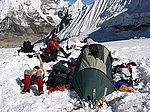 |
The snow continued
for 24 hours, while impressive avalanche sounds ripped out of
the clouds from all angles. The next day was bright and blue again,
but we were camp-bound while the snow began to melt and stabilise.
Some of the fluted snow faces around us, which seemed to change
daily, began to show a disconcerting tendency simply to peel off
the rock beneath. The following day we regained high camp, where
30cm of new snow had collapsed the tent. Dawn found Bruce and
Andi breaking a new trail, first below the impressive N end of
the Kyashar ridge, and then steeply up through a zone of large
crevasses, emerging on a shoulder at 6400m with a view of Everest,
Lhotse and Ama Dablam. A saddle at 6500m below the summit pyramid
offered the goal for the day: an uninterrupted view of Kyashar,
lying directly due S and looking as forbidding as ever. Andi spent
some time glassing the W Ridge, now visible almost in its entirety.
After a night back at high camp, Andi and Bruce walked over to
the base of col 6034m, failing even to reach the start of the
steep stuff due to unexpected avalanche danger on the slopes below
the face, which was washed by a steady and worrying stream of
ice spicules. Our consensus was clear: the N side might be climbable,
but is not protectable in post-monsoon snow conditions. We packed
up and headed down to BC. |


|
We used the
rest day which followed to refine a plan. Kevin had decided he
was not happy with the prospect of technical climbing above 6500m;
Andi, Bruce and Sam had no problem with an attempt on the W Ridge.
Logistically, this would mean a single, alpine-style bid from
Tangnag, leaving the clearing of BC to Dhan Kumar and Pasang,
whom we would meet with the porters in Tangnag afterwards. Legally,
Bruce thought that changing routes on the same mountain required
a 25% surcharge on the permit, which we were prepared to face.
In the absence of an LO to consult we would climb first and ask
questions later. |
 |
After a lengthy
packing exercise we shouldered distressingly heavy rucksacks and
left BC in Dhan Kumar's capable hands. The upper Hinku Nup seemed
even more malevolent in the other direction, and we camped on
grass at Dig Kharka. Kevin went up to Khare, where he joined an
Australian trekking group as stand-in assistant guide and climbed
Mera. Andi, Bruce and Sam made good time down to Tangnag, then
excruciatingly slow progress up the morainal slopes W of the village,
finding a bivouac spot on the only flat rock in a boulderscape
around a miniature lake. |
 |
The next day
began at 1am, with the sole aim of crossing boulder fields to
the base of the huge S Face, and climbing 800m of snow slopes
directly beneath it before the sun came up and rockfall began.
Sunrise found the trio climbing out of the last ice gully between
the face and the seracs of the neighbouring glacier, emerging
on snow slopes below the 5800m col separating Kyashar from Kusum
Kanguru. A flat, windless spot 50m below the col made an ideal
high camp with a view of the S Face and W Ridge. The part of the
ridge visible from the Kangtega Glacier was separated from the
col by a 100m rock step, definitely vertical in places and of
decidedly dubious-looking quality. Taking the 2 ropes and the
rock rack, Andi and Bruce went to look at this obstacle: the easiest
line was vertical for 25m, and the rock quality indeed execrable,
but Bruce was able to find some forms of protection. The two climbed
a third pitch, looser but no longer steep, to establish that the
way to the ridge was clear, then fixed the ropes on the first
two pitches while descending. As on previous days, cumulus rose
on a cool W wind, but was gone by sundown; the weather looked
to be set fair for summit day. |


|
After a cold,
slow start jumaring the ropes, the team gained the W Ridge by
8am. The corniced, unpleasant-looking ridge turned out to be relatively
straightforward: strong melting made the footing mostly firm on
the S side, and where this dropped vertically tracks could be
made on the deep, soft N side. Bruce broke trail and placed snow-stake
protection for the long, steepening traverse, bringing the party
to 6400m shortly after noon. Here the W Ridge becomes steep and
rocky, and the route lies to the left in the couloirs of the W
Face. Our chosen couloir began as soft snow for one pitch, but
turned to perfect ice for the next three, letting Bruce set good
ice-screw protection (and later Andi, leading the descent, set
good Abalakov anchors). The couloir turned back to firm snow between
the exposed rock sections of the upper face, then broadened into
a long exit slope. Bruce arrived on the summit ridge 20 horizontal
metres from the highest point, which turned out not to be a cornice,
so the team gathered on the true summit. Timecheck: 4pm. Ritual
handshakes were exchanged and photos taken, but enjoyment of the
extensive view was curtailed by the cold W wind and by the sure
knowledge of being only half-way there. One look down the NE Face
confirmed that the final route choice was not a mistake. After
some compulsory food and drink the team headed back into the W
Face and the lowering sun. Night fell in the couloirs of the upper
face, but the footprints on the ridge were clear to follow, and
the anchors in the rock band were in place. At 1am the group was
back at high camp, where Sam manfully kept the stove alight until
hydration and thawing had been achieved all round. |
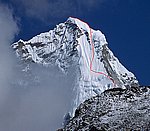


|
Descent below
the S Face would require a 3am start, so safety and torpor dictated
a semi-comatose 24-hour break. At the appointed hour the group
struck camp and, with two abseils, passed the serac narrows to
walk down and out of the snow slopes below the face, admiring
the sunrise from the safety of the earlier bivouac site. After
breakfast in Tangnag, first Kevin and then Dhan Kumar with the
porter train arrived from Khare. In talking with different trekkers
and Nepalis, we learned that every expedition in the valley after
ours had been met near Tashing Ongma by some gentlemen with AK47s
requesting a ``donation'' to the Maoist cause: 1000Rs per foreign
trekker and 500Rs per porter. Popular support was not in evidence
among the locals. Sam had sustained a contusion on his left hand
from stonefall during the abseils, and this was treated by some
attentive female doctors. We would finish our expedition by trekking
over the Mera La and Amphu Labsta to the Khumbu, and thence back
to Lukla, so spent the day drying gear and reconfiguring our loads
and those of the porters. They and Dhan Kumar would leave the
next morning to return to Lukla, and thereafter either home to
their families for the Diwali (New Year) holiday or straight out
on another trek to earn more high-season income. Dhan Kumar marked
the occasion with a Kyashar cake, featuring icing-sugar snow and
seracs over steep, red-walled sponge. |


|
| Our porters duly made it back with
no rebel attention. We completed our Hinku/Hongu/Khumbu experience
with a detour via Mera, the relative solitude of the upper Hongu,
a snowstorm and avalanche danger on the Amphu Labsta, a school festival
in Dingboche, awe-inspiring views of the Lhotse wall and of Ama
Dablam from Pangboche, a morning service at Tengboche, the calm
of Khumjung, the commercial chaos of Namche and the warm, green
forests of the lower Khumbu. At the Sherpa Lodge we rearranged flights,
and established that Dhan Kumar had dealt with all the garbage,
recyclables and paperwork for redeemimg the environmental bond.
While Andi and Sam flew to Kathmandu for a brief look at lowland
Nepal, Bruce and Kevin returned to Khunde hospital with a medical
donation. Eike Mrosek, trauma surgeon, Everest summitter and friend
of the expedition, had asked us to deliver a significant amount
of broad-spectrum liquid antibiotics of the type which save the
lives of children with pneumonia. |

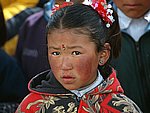
|
Back in Kathmandu, the leader had
just arrived at his hotel reception when Miss Hawley called to schedule
her post-expedition debriefing. The next priority was HM Government,
negotiated with aplomb by WildEx's faithful driver Tenzing: in a
display of unprecedented bureaucratic efficiency, Bruce was steered
through the Department, the Ministry and the Central Bank of Nepal,
at 3 different places in town, requiring the attention of 5 government
functionaries and the disbursement of 1000USD in hard currency,
in just 1.5 hours. The final piece of expedition business was to
transfer some of this currency directly to Dhan Kumar: in 5 weeks
of work he hadn't put a foot wrong, whether moving our equipment,
arranging our provisions, cooking our food, spending our money,
ensuring the safety of the porters or dealing with bureaucracy.
He'd done it all with or without our ``oversight'', with good humour
and helpful advice, and had more than merited a generous tip. He
bade us farewell by presenting us all with katas (traditional silk
scarves) ``until next time''.
|
 |
| The Kyashar team would like to thank the Akademischer Alpen-Club
Zurich for the club's generous support of the expedition. |
|
|























